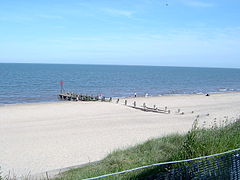|
Hopton-on-Sea
Hopton-on-Sea is a village, civil parish and seaside resort on the coast of East Anglia, in the county of Norfolk, England. It is located 4 miles (6 km) south of Great Yarmouth and 5 miles (8 km) north-west of Lowestoft. History  The village's name means "Farm/settlement in enclosed spot"; it is perhaps referring to the promontory jutting into marsh.[1] The earliest human activity in the parish dates to the Palaeolithic era, with the discovery of flint tools. There have also been artefacts found from the Bronze Age and Roman era in the area.[2] The oldest building in the parish is the ruin of St Margaret's church, built in the 14th century; it burned down in 1865.[2] The ruins of the old church are being restored to form a cultural centre for the village. As part of the £140,000 restoration project by the Great Yarmouth Preservation Trust, gargoyles were found on the site from the previous 11th century church.[3] A new church of the same name was built the following year in Early English style on a new site,[2] which is still in use today. Designed by Samuel Sanders Teulon, it contains stained glass by William Morris and Edward Burne-Jones. During World War II, a dense network of military defences were built in the area due to Hopton's close proximity to Great Yarmouth. These included anti-tank defences, pillboxes, air-raid shelters and a coastal battery. Constructed in 1940, this battery had a pair of large gun houses, four six-inch guns and search-lights. The site was armed during and after the war, until August 1947, due to its prime location for an invasion.[4] GeographyThe village is sited on the East Anglia coast, beside the North Sea; it has a wide sandy beach, Hopton-on-Sea Beach, which runs by grassy cliffs.[5] The beach suffers from coastal erosion and, as of 2016, sand levels have dropped by 10 ft in the last five years. The erosion has led to a project to replace the old wooden groynes, with ones made of rock and the construction of a seawall. These defences are estimated to protect the area for up to a century.[6] The civil parish was, until 1974, in the county of East Suffolk. It has an area of 2.17 square miles (5.6 km2) and, in the 2011 Census, it had a population of 2,970 in 1,325 households.[7][8] For local government, the parish falls within the district of Great Yarmouth. AmenitiesThe village has many amenities for tourists with amusement arcades and food outlets. It is also home to Potters Resorts, "the UK’s only all-inclusive holiday resort", which was founded in 1920.[9] It employs approximately 560 permanent staff, making it the largest private sector employer in the area. TransportFirst Eastern Counties operates local bus services, with routes connecting the village with Norwich, Great Yarmouth and Lowestoft.[10] Hopton-on-Sea railway station was a stop on the Yarmouth-Lowestoft line, which linked Yarmouth Beach and Lowestoft. The line and the station were closed in 1970, as part of the Beeching Axe.[11] SportEvery January, Hopton-on-Sea hosts the World Indoor Bowls Championships at Potters Resorts; players, spectators, the BBC and many others staying in the village for what is regarded as the biggest event in the bowls calendar.[12] Notable former residents
References
External links
Wikimedia Commons has media related to Hopton on Sea. |
||||||||||||||||||||||||||||||||||||||||
Portal di Ensiklopedia Dunia

